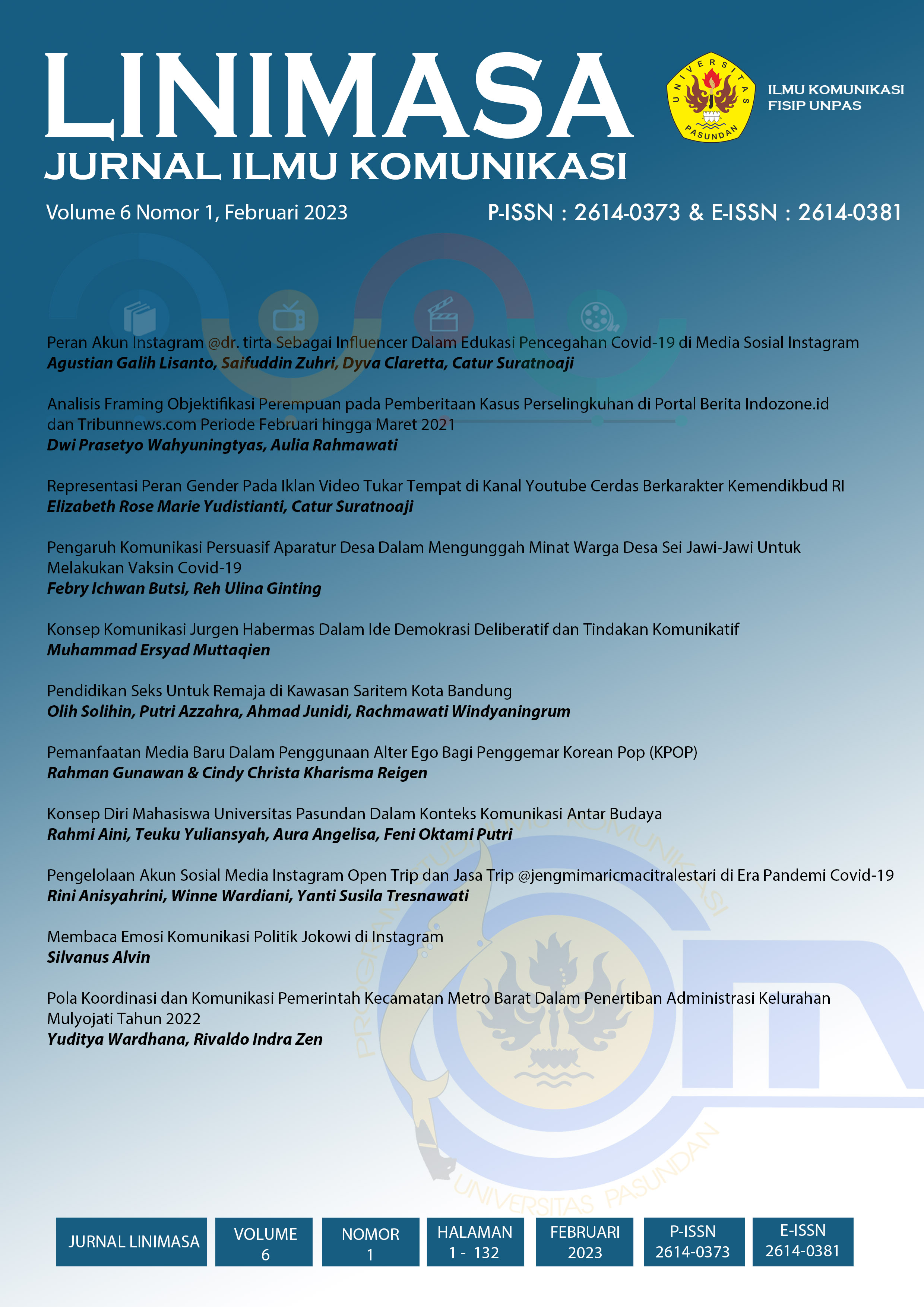REPRESENTASI PERAN GENDER PADA IKLAN VIDEO TUKAR TEMPAT DI KANAL YOUTUBE CERDAS BERKARAKTER KEMENDIKBUD RI
Keywords:
Advertising, Gender Role, New Media, RepresentationAbstract
Advertising is a form of mass media product that presents various benefits. In modern times, advertising has developed so that it is made in new media in the form of social media. This study discusses the Indonesian Ministry of Education and Culture's "Tukar Tempat" advertisement, which is an audio-visual advertisement has been published on the Cerdas Berkarakter Kemendikbud RI Youtube channel. Tukar Tempat is a public service advertisement with the theme of gender with the issues discussed in this study the gender role of the husband figure who also has a background in the Covid-19 pandemic phenomenon which has an impact on the realm of domestic life. The purpose of this study is to determine the representation of gender roles in Tukar Tempat as public service advertisements with John Fiske's semiotic analysis in 12 scenes. This research is a descriptive qualitative research using John Fiske's semiotic analysis which consists of the level of reality, the level of representation, and the level of ideology. The data collection technique uses primary sources in the form of scene snippets of the "Tukar Tempat" video advertisement on YouTube and secondary sources from books, journals and relevant articles. The results of the study show that the depiction of gender roles in the reality level shows characteristics of masculinity, the level of representation of gender roles in the domestic sphere is weak, and the level of advertising represents gender roles followed by ideologies, gender, feminism, masculinity, patriarchy and matriarchy, domesticity, male chauvinism.
Downloads
References
Anggiana, R. (2020). New UN Report Unveils the Heavy Toll on Women and Girls Left Behind During COVID-19. https://asiapacific.unwomen.org/en/news-and-events/stories/2020/10/new-un-report-unveils-the-heavy-toll-on-women-and-girls-left-behind-during-covid-19
Barker, C., & Jane, E. . (2016). Cultural Studies Theory and Practice by Barker, C. and E. A. Jane (C. Rojek (ed.); 5th Editio). London: SAGE Publications.
Bayu, D. J. (2020). Perempuan Tanggung Pekerjaan Rumah Lebih Banyak saat Pandemi. https://databoks.katadata.co.id/datapublish/2020/11/05/perempuan-tanggung-pekerjaan-rumah-lebih-banyak-saat-pandemi
Diani, A., Lestari, M. T., & Maulana1, S. (2017). Representasi Feminisme Dalam Film Maleficent. ProTVF, 1(2), 139–150. https://doi.org/10.25124/liski.v1i2.818
Fakih, M. (2013). Analisis Gender & Transformasi Sosial. Yogyakarta: Pustaka Pelajar.
Fiske, J. (1987). Television Culture. New York: Routledge.
Hanum, F. (2018). Kajian Dinamika Gender. Malang: Intrans Publishing.
Hassan, H. (2022). Male Chauvinism, Cultural Hybridity and Racism in the Society of Indian Sub-Continent: A Study of Bollywood’s Film Pinjar Semiotically. Creative Saplings, 1(3), 1–16. https://doi.org/10.56062/gtrs.2022.1.3.1
Jackson, R. M. (2013). Chapter 8. Disputed Ideals : Ideologies of Domesticity and Feminist Rebellion. Sociology of Sex and Gender, 193–228. http://www.nyu.edu/classes/jackson/future.of.gender/Readings/DownSoLong--Ideology.pdf
Kementerian Pemberdayaan Perempuan Dan Perlindungan Anak Republik Indonesia. (n.d.). Glosary Gender. Retrieved June 4, 2022, from https://www.kemenpppa.go.id/index.php/page/view/20
Littlejohn, S. W., & Foss, K. A. (2009). encylopedia of Communication Theory. London: In SAGE. https://doi.org/10.4324/9781315228846-3
McQuail, D. (2011). Teori Komunikasi Massa McQuail Edisi Buku Denis McQuail (Edisi 6). Jakarta: Salemba Humanika.
Moriarty, S., Mitchell, N., & Wells, W. (2011). Advertising. Jakarta: Kencana.
Nugroho, R. (2008). Gender dan Strategi Pengarus-Utamaannya di Indonesia (1st ed.). Yogyakarta: Pustaka Pelajar.
Puspitawati, H. (2010). Persepsi Peran Gender. Jurnal Studi Gender Dan Anak, 5(1), 17–34.
Puspitawati, H. (2013). Konsep, Teori, dan Analisis Gender. Departemen Ilmu Keluarga Dan Konsumen Fakultas Ekologi Manusia Institut Pertanian.
Rafayan Kharisma, S., & Achmad Ismail, O. (2022). Counter Hegemoni Matriarki Dalam Keluarga Ras Kulit Hitam. V(I), 1–16.
Rakhmat, Jalaluddin; Ibrahim, I. S. (2017). Metode Penelitian Komunikasi (R. Soenendar (ed.); Edisi Revi). Bandung: Simbiosa Rekatama Media.
Rakhmat, J. (2019). Psikologi Komunikasi (Edisi Revi). Bandung: Simbiosa Rekatama Media.
Setiawati, T. (2020). Representasi Budaya Patriarki Dalam Film Istri Orang. Komunika, 7(2), 66–76. https://doi.org/10.22236/komunika.v7i2.6328
Sobur, A. (2018). Semiotika Komunikasi (7th ed.). Bandung: PT Remaja Rosdakarya.
Sugiyono. (2019). Metode Penelitian Kuantitatif Kualitatif dan R&D (Sutopo (ed.); 2nd ed.). Penerbit ALFABETA Bandung.
Vera, N. (2015). Semiotika dalam Riset Komunikasi (R. Sikumbang (ed.)). Bogor: Ghalia Indonesia.
Wahid, U., & Lancia, F. (2018). Pertukaran Peran Domestik dan Publik Menurut Perspektif Wacana Sosial Halliday. Mediator: Jurnal Komunikasi, 11(1), 106–118. https://doi.org/10.29313/mediator.v11i1.3180















